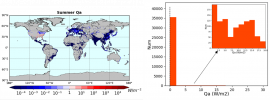Hi all,
I am a little puzzled by my anthropogenic heat flux result from an I2000Clm50SpGs run. It is much smaller than I expected (Figures attached). I am using CLM5 and in the user_nl_clm I specified:
urban_hac='ON_WASTEHEAT'
building_temp_method=1
I calculated Qanthro as (HEAT_FROM_AC+WASTEHEAT)/Total PCT_URBAN. The Qanthro should be the anthropogenic heat flux with respect to the urban area. However, I found that only U.S. cities have Qanthro of 2-20W/m2, and cities from other counties have near-zero Qanthro. I know that CLM does not consider heat from the traffic system and will underestimate anthropogenic heat. But the Qanthro I got is surprisingly low for the non-US cities (I felt that they should not be 0...). Is this a normal behavior of CLM5?
Also, I wonder if there are any setups I can use to get higher Qanthro. For example, try building_temp_method=0?
Thank you very much!!
I am a little puzzled by my anthropogenic heat flux result from an I2000Clm50SpGs run. It is much smaller than I expected (Figures attached). I am using CLM5 and in the user_nl_clm I specified:
urban_hac='ON_WASTEHEAT'
building_temp_method=1
I calculated Qanthro as (HEAT_FROM_AC+WASTEHEAT)/Total PCT_URBAN. The Qanthro should be the anthropogenic heat flux with respect to the urban area. However, I found that only U.S. cities have Qanthro of 2-20W/m2, and cities from other counties have near-zero Qanthro. I know that CLM does not consider heat from the traffic system and will underestimate anthropogenic heat. But the Qanthro I got is surprisingly low for the non-US cities (I felt that they should not be 0...). Is this a normal behavior of CLM5?
Also, I wonder if there are any setups I can use to get higher Qanthro. For example, try building_temp_method=0?
Thank you very much!!

